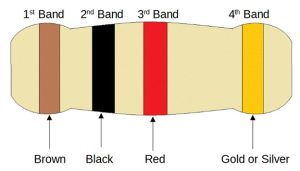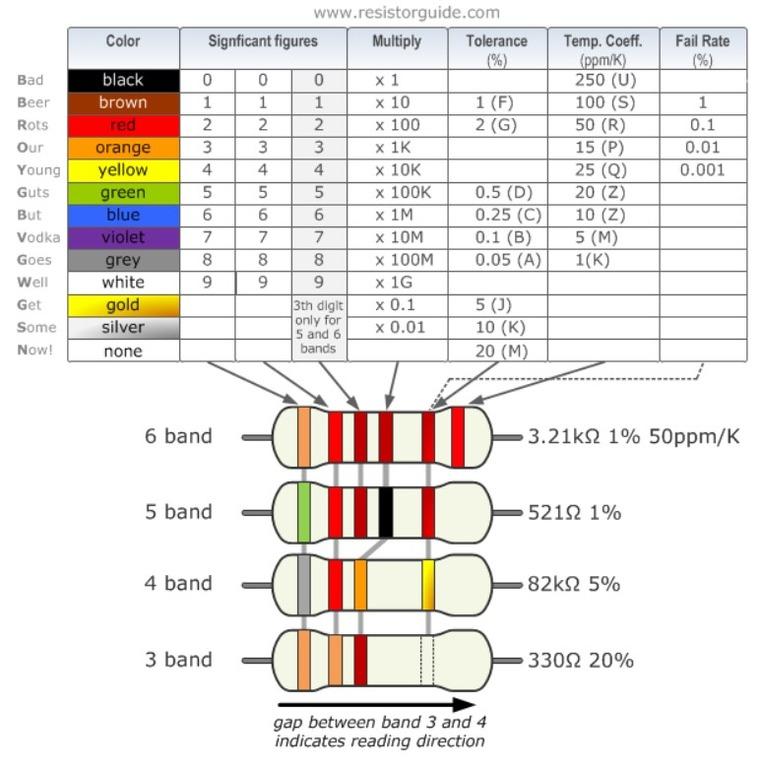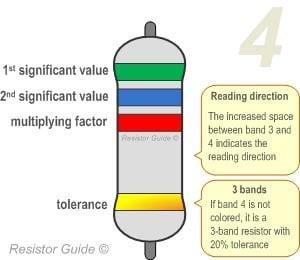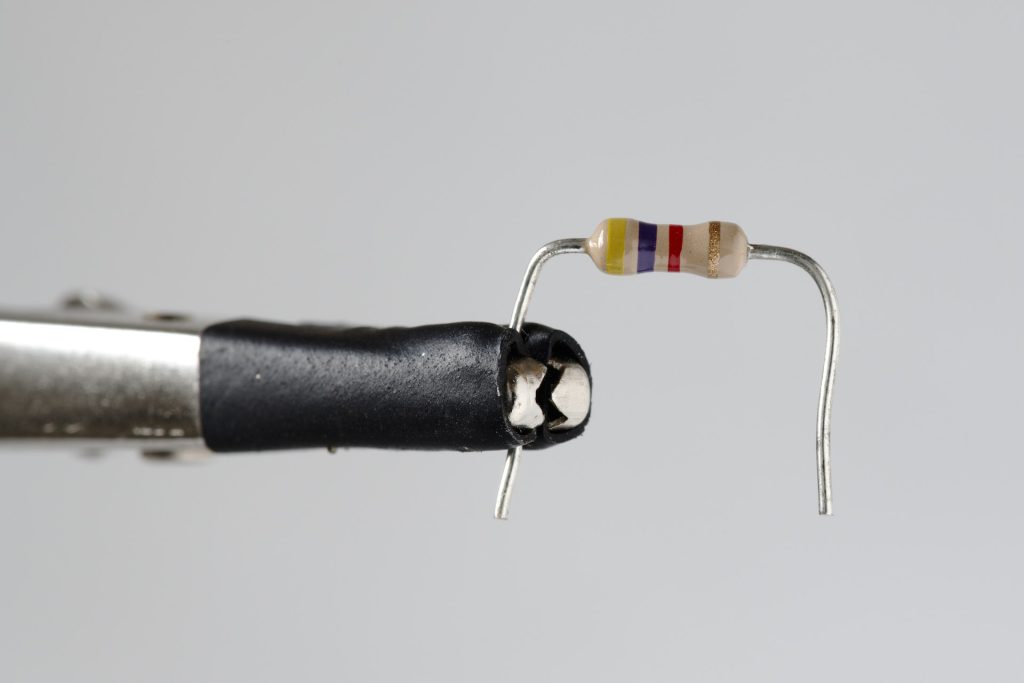Let's Learn Electronics
Resistors Color Code – A Comprehensive Guide
Resistors are an essential component of electronic and electrical circuits to control the current flow. They are available in different resistance values, starting from fractions of an Ohm (Ω) to going up to millions of Ohms. The resistance value and tolerance are mostly printed onto the resistor’s body, either in the form of numbers, letters, or color codes. Almost all leaded resistors having a one-watt power rating use color patterns to reflect the resistance value, tolerance, or even temperature coefficient.
Reading the resistor value manually becomes a lot easier after understanding the math behind resistors’ color codes. Therefore, this blog provides a comprehensive guide on the resistors color code system, covering all the information you need to master reading the color codes of resistors.
Resistors Color Code – A Quick Overview
Resistor color codes are color bands circled around resistors to reflect their resistance value, tolerance, and other properties. The colored bands can be between three to six bands, but primarily resistors with four bands are most common.
The first few bands in a resistor’s color code represent the digits of the resistance value. Afterward, a multiplier band represents the value at which the digits are to be multiplied. Lastly, there is a tolerance band or temperature coefficient (occasionally). Resistor tolerance represents the variation in resistance value from the specified resistive value.
The color codes of a resistor are read from left to right. To determine the right direction, look for the color band closest to the lead, as it is the first color band. Alternatively, search for a larger gap between color bands. There will be a larger gap between the second-last and last color band, reflecting the direction from where to read.
To better understand the basics of resistors color code, let’s take resistor color code 1K as an example and read its color bands.

The above picture shows the color codes of a 1 KΩ resistor. It is a 4-band resistor, including a combination of brown, black, red, and gold/silver color bands. The calculation of the color band is presented in the below table:
| Band Number | Function | Color | Value |
| 1 | 1st Digit | Brown | 1 |
| 2 | 2nd Digit | Black | 0 |
| 3 | Multiplier | Red | x100 |
| 4 | Tolerance | Gold (or silver) | ± 5% |
|
Total Resistance Value: |
1000 ± 5% Ω |
||
This way, knowing which ones are digits, multipliers, and tolerance and using the right numeric values for color can let you calculate the resistance value from every resistor color code.
Resistors Color Code Chart
Before we discuss in detail how to calculate resistor color code, let’s go through the resistors color code chart that provides a bigger picture of how resistance is calculated.

Based on the above resistors’ color code chart, it is evident that different colors can represent different meanings for different resistors. For instance, the brown color can be a numeric digit with the value “1”, a multiplier with the value “101“, or a tolerance with the value ± 1%. All it depends on is at which place the color code is placed in a resistor.
How to Calculate Resistor Color Code Values
The resistor color code system is a standardized and well-structured system that makes it easy to quickly find the resistance value of the resistor without using an ohm meter. However, it requires a proper understanding of how to use resistor color code to calculate values.
The first thing to understand is where to start reading the color code. The resistor color code bands are read one band at a time, from the left to the right. To determine which side is left and right, you have to look into the spacing of the color bands. The first color band is the one that is nearest to the connecting lead. Similarly, you will see a large gap between the second-last and last (tolerance) color bands. Both these indicators can help you determine the left and right sides of the resistor.
Once you know where to start reading the resistor value, the next thing is exacting the numeric value from the color codes. For that, use the below table as a reference to easily calculate the resistance value from color codes.
| Color | Digit | Multiplier | Tolerance | Temperature Coefficient |
| Black | 0 | 1 (=100) | 250 ppm/K | |
| Brown | 1 | 10 (=101) | ± 1% | 100 ppm/K |
| Red | 2 | 100 (=102) | ± 2% | 50 ppm/K |
| Orange | 3 | 1,000 (=103) | 15 ppm/K | |
| Yellow | 4 | 10,000 (=104) | 25 ppm/K | |
| Green | 5 | 100,000 (=105) | ± 0.5% | 20 ppm/K |
| Blue | 6 | 1,000,000 (=106) | ± 0.25% | 10 ppm/K |
| Violet | 7 | 10,000,000 (=107) | ± 0.1% | 5 ppm/K |
| Grey | 8 | ± 0.05% | 1 ppm/K | |
| White | 9 | – | – | – |
| Gold | – | – | ± 5% | – |
| Silver | – | – | ± 10% | – |
| None | – | – | ± 20% | – |
Calculating Resistor Color Code for 4 Band Resistors
The 4-band resistor color code is the most common variation. It includes four color bands, where the first and second color bands represent the numeric digit, the third color band represents the multiplier, and the fourth color band represents the tolerance.

Let’s consider the resistor color code 1K as an example and see how to calculate the resistor color code for 4 band resistors. The below pictures show the color codes of a 1K ohm resistor. It includes a combination of brown, black, red, and gold color bands.

Using the above color code table, the values of the color bands in a 1K ohm resistor are:
- Brown = 1
- Black = 0
- Red = 102
- Gold = ± 5%
So, the calculation will be:
1 0 * 102 ± 5% = 1000 ± 5% = 1K ± 5%
This way, you can calculate the resistor color code for 4 band resistors. If the 4th band is in silver, then the tolerance will be ± 10%. It is not necessary that a resistor 1K or higher will have four bands. Even a resistor color code of 100 ohm can have four color bands, such as brown (1), black (0), brown (101), and gold (± 5%).
Note: If the 4th color band is not colored, then it is not a 4-band resistor. Instead, it is a 3-band resistor with the 4th color band as ± 20% tolerance.
Calculating Resistor Color Code for 5 Band Resistors
The 5-band resistor is more precise than the 4-band resistor. It includes five color bands, where the first, second, and third color bands represent the numeric digits, the fourth color band represents the multiplier, and the fifth color band represents the tolerance.

Let’s consider the resistor color code 10K as an example to better understand the calculation of resistor color code for 5 band resistors. The below pictures show the color codes of a 10K ohm resistor. It includes a combination of brown, black, black, red, and brown color bands.

Using the above color code table, the values of the color bands in a 10K ohm resistor are:
- Brown = 1
- Black = 0
- Black = 0
- Red = 102
- Brown = ± 1%
So, the calculation will be:
1 0 0 * 102 ± 1% = 10000 ± 1% = 10K ± 1%
This way, you can calculate the resistor color code for 5 band resistors.
Note: If you see a gold or silver color band in the 4th color band, then it’s not a 5-band resistor. Instead, it is a 4-band resistor with the 3rd color band as a multiplier, the 4th color band as tolerance, and the 5th color band as temperature coefficient.
Calculating Resistor Color Code for 6 Band Resistors
The 6-band resistor is even more precise than the 5-band resistors. This band often includes an additional band to represent the temperature coefficient. In a typical 6-band resistor, the first, second, and third color bands represent the numeric digits, the fourth color band represents the multiplier, the fifth color band represents the tolerance, and the sixth band represents the temperature coefficient.

Let’s consider the resistor color code 500K as an example and see how to calculate the resistor color code for 6 band resistors. As per the below picture of a 500K ohm resistor, it includes a combination of green, black, black, orange, gold, and brown color bands.

Using the above color code table, the values of the color bands in a 500K ohm resistor are:
- Green = 5
- Black = 0
- Black = 0
- Orange = 103
- Gold = ± 5%
- Brown = 100 ppm/K
So, the calculation will be:
5 0 0 * 103 ± 5% = 500000 ± 5% = 500K ± 1% 100 ppm/K
This way, you can calculate the resistor color code for 6 band resistors.
Note: In some military standards, the 6th color band represents the reliability brand, which is the failure rate (%) per 1000 service hours.
The below table provides a concise look at the different weighted positions of every color code in all resistor bands:
| Color Codes | 3-Band Resistor | 4-Band Resistor | 5-Band Resistor | 6-Band Resistor |
| 1st Color Code | 1st Digit | 1st Digit | 1st Digit | 1st Digit |
| 2nd Color Code | 2nd Digit | 2nd Digit | 2nd Digit | 2nd Digit |
| 3rd Color Code | Multiplier | Multiplier | 3rd Digit | 3rd Digit |
| 4th Color Code | – | Tolerance | Multiplier | Multiplier |
| 5th Color Code | – | – | Tolerance | Tolerance |
| 6th Color Code | – | – | – | Temperature Coefficient |
How to Calculate Resistor Color Code Values Without Table
Now that you know all the basics to calculate resistor color code for any band, the next question is how to calculate resistor color code values without a table. When you frequently use the color code chart to calculate resistance values, you will gradually memorize all the color codes and their corresponding values.
Alternatively, the much easier way to remember the color code chart is in the form of sentences called acrostic, where the first character of each word represents the color code. There are many different sentences/phrases you can remember for resistors color code, as follows:
- Better Be Right Or Your Great Big Venture Goes Wrong
- B. Roy Of Great Britain Veto Getting Wed
- BB ROY Of Great Britain (had a) Very Good Wife
You can memorize these phrases or come up with your own unique sentence. This way, you can know the sequence of color codes and can then easily remember the digit, multiplier, and tolerance associated with color codes.
Resistor Color Code Exceptions
There are a few resistor color code exceptions that are important to know about. A few of those main exceptions are listed below:
1. Zero Ohm or Single Black Band Resistor
A zero-ohm resistor is a resistor that has a single color band of black color. It is used to replace jumpers and make certain connections in PCB. During mass PCB production, manufacturers use the “pick-and-place” machine, which cannot unroll and cut jumper wires. For that, they require another machine, which can make the process costly and delayed. Therefore, a zero-ohm resistor is used in such cases to make connections in PCB where jumper wires are required.
2. Yellow/Gray Color Codes Instead of Gold/Silver
In some resistors, especially high-voltage ones, the gold and silver color bands are replaced with yellow and gray. This is meant to free the resistor coating from metal particles.
3. 5-Band Resistors with Gold/Silver 4th Band
A 5-band resistor that includes gold or silver as the 4th band reflects some old or specialized resistors. In these resistors, the 1st and 2nd bands are digits, the 3rd band is the multiplier, the 4th band is the tolerance, and the 5th is the temperature coefficient.
4. Reliability Band
Resistors designed specifically based on military specifications include an extra band to reflect reliability. It is mostly mentioned in terms of failure rate (%) per 1000 service hours. It is commonly seen in 4-band resistors but rarely in commercial electronics.
Conclusion
The resistors color code system is a standardized practice followed globally. Once you master how to calculate resistance value and tolerance with the color codes of a resistor, you will never need an ohm meter to measure resistance. This blog provided a thorough guide on how to calculate resistor color code values for different resistance bands. So, keep this guide as your reference and gradually become an expert in measuring the resistance value in seconds through a quick glimpse of the color bands.

